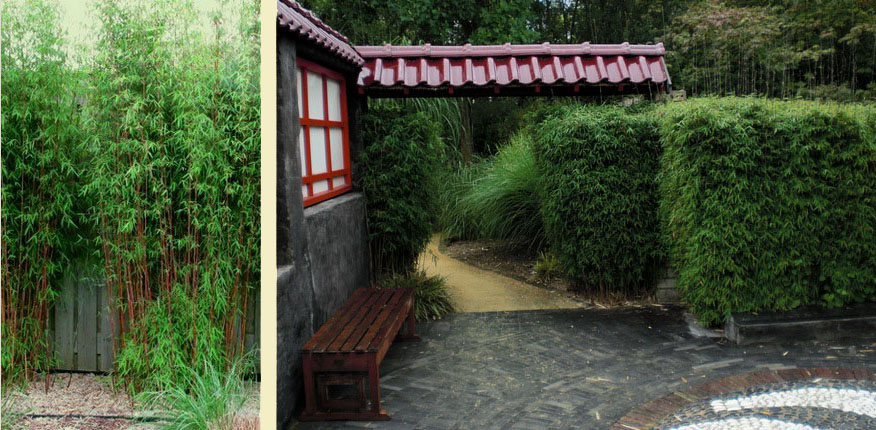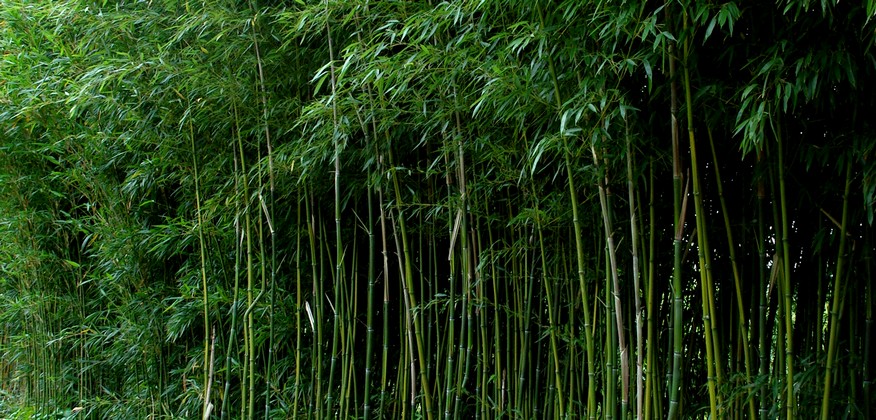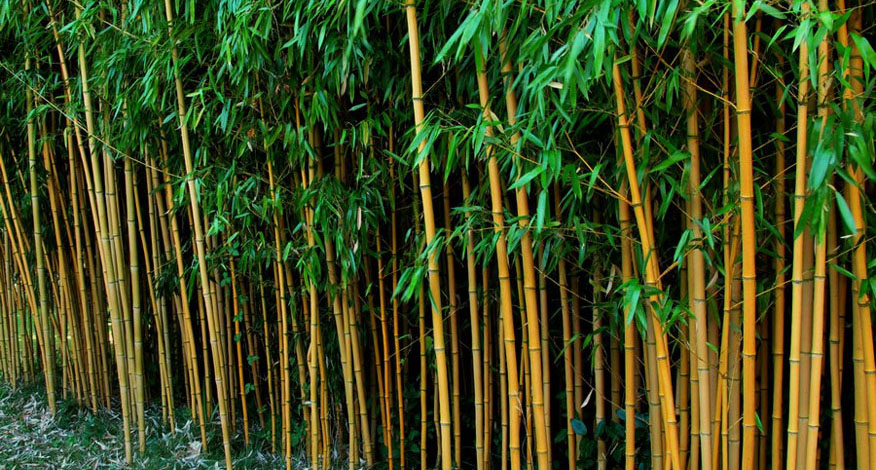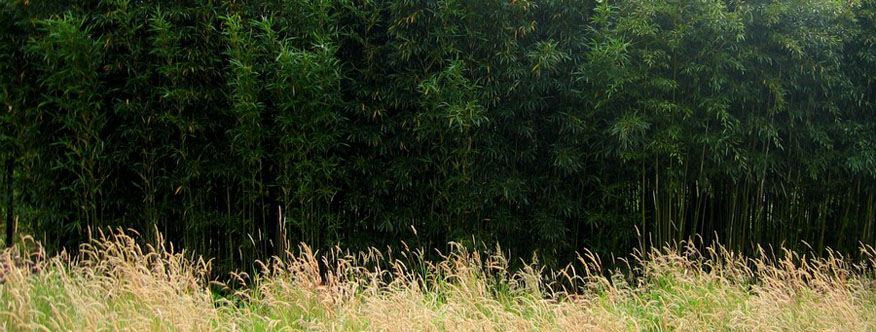| Zandbergstraat 14 / 5555 LB Valkenswaard (NL) ☎ + 31(0)651 587 997 Opening hours: Friday and Saturday: 10 till 16 and also by appointment. |
| Bamboo hedges. The best species Bamboo as a hedge. Suppose, your neighbor has built a new garage with a yellow wall that is 3 meters high and you choose to cover it with bamboo because you don’t want to see it all year round . In such a situation it is best to choose types from the non-invasive Fargesia. But when the neighbor also builds on the roof of the same garage a huge balcony where his family regularly have parties you only can choose for the bigger running bamboo. There are several species of Phyllostachys, Semiarundinaria and Pseudosasa you can use for this purpose. These bamboos can become quickly 5 meters or higher and they are densely leafy. Such a planting will ensure you that you don’t have to see the garage in summer and winter. (translation of the rest will follow)tion of the rest will follow) |
|||
 |
|||
| Practice There are many reasons to use bamboo in a garden. Bamboo is green in winter, rustles in the wind, provides privacy and an exotic “faraway lands” atmosphere. The impulsive step to purchase bamboo is quickly made. And before you know it, you or your gardener have created a bamboo hedge. Only then do the questions arise: What type of bamboo do I have and does it fit in my garden, why does it grow like that and what maintenance do I need to do? Actually, these questions should be asked before you begin. Your plans with bamboo hedges have a better chance of success if you seek advice and guidance from our expert team. Important: We have removed almost all varieties of the species Fargesia murieliae such as 'Bimbo', 'Jumbo', Superjumbo' and 'Simba' from our recommendation list, despite their impressive names. These species usually disappoint due to their sensitivity and susceptibility to diseases. We also advise against Phyllostachys aurea (due to its sensitivity to frost) and Phyllostachys nigra (the black bamboo that has currently started its flowering period in many places). You can choose between two types of bamboo: non-invasive types (between 1 and 4 (5) meters+ high) and the taller invasive types (between 4 and 8+ meters high) that can spread underground and require means that prevent this. |
|||
 |
|||
|
|||
| Fargesia robusta 'Campbell' | |||
 |
|||
| Fargesia robusta 'Campbell' is
the most important Fargesia species for creating a compact higher hedge
that can grow up to 4 (5) meters high. This type with small glossy
leaves is the first Fargesia robusta to be imported into Europe. And
only this variety of the now form-rich group Fargesia robusta survived
the late winter of March 2005 with -21 C in the northern Netherlands and
Germany. This is also the most compact and most upright growing form. About 30 years ago, Fargesia robusta flowered in China. If we assume that this information is true and that this bamboo comes from that flowering period, then Fargesia robusta “Campbell” is one of the species for which no new flowering period is expected for the time being. |
|||
 |
|||
| (photo left) The upright silhouette, the small
glossy leaves, the relatively thick culms and the beautiful white
culmsheats on the new shoots make Fargesia robusta 'Campbell' the best choice when looking for a hedge up to 4 (5) meters
high may be. This species grows well in a sunny growing location. (photo right) Fargesia robusta 'Campbell' can also be pruned into a tight hedge, but the growth pattern must be taken into account. When the hedge has been pruned back to, for example, 2.5 meters, the new shoots will grow through it again during the growing season and these can again be a meter higher than the hedge. These must be pruned back to the desired height of 2.5 meters so that the original shape is restored. |
|||
 |
|||
| The leaves of Fargesia robusta 'Campbell' do not roll on themselves in frost, drought and sun. | |||
| Fargesia sp. Jiuzhaigou 1 (syn: Fargesia sp. Jiu) | |||
 |
|||
| Fargesia sp. Jiuzhaigou 1 (syn:
Fargesia sp. Jiu) Many people want a bamboo that grows 2 to 3 meters
high, has fine leaves and grows compactly and upright. Therefore,
Fargesia sp. Jiuzhaigou 1 is the first choice in places with less space.
With the help of pruning and demarcation, this bamboo can even maintain
a width of less than 1 meter, but a large meter is better. Fargesia sp.
Jiuzhaigou 1 tolerates the sun if the soil is humus-rich and not dry. The culms of this bamboo can develop a red haze in the spring sun and sometimes turn red. Over the course of the summer, this color changes to more orange-yellow and in late summer new deep green culms form between them. These new culms hardly get branches in the first year. This very hardy bamboo can roll up its leaves into needles during severe frost in winter and early spring, making them more transparent. These will roll out again in humid weather. During the course of April, numerous fresh new leaves will form and a dense hedge will be there again. |
|||
 |
|||
|
|||
 |
|||
| Fargesia 'Rufa' is a lush growing bamboo with bright green, shiny leaves and graceful, somewhat sagging branches. This species was imported from China by the nursery in 1995 and has since made a worldwide career. The growth height is between 2 and 2.5 meters. Fargesia 'Rufa' is one of the hardiest and best evergreen species. This bamboo tolerates sun and shade well and quickly grows into a wider hedge. Without pruning, take into account a plant width of 1.5 to 2 meters. 'Rufa' is suitable for group planting in public green areas, but is also beautiful as a solitary plant. It is also the best bamboo species to create a screen in larger tubs or containers on a balcony. The leaves do not roll up, so this bamboo remains beautiful and green even in winter. | |||
| Fargesia 'Rufa' can also be pruned into a tight hedge, but the growth pattern must be taken into account. When the hedge has been pruned back to, for example, 1 meter, the new shoots will grow through it again during the growing season and these can again be a meter higher than the hedge. These must be pruned back to the desired height of, for example, 1 meter so that the original shape is restored. | |||
| Fargesia nitida x murieliae 'Obelisk' | |||
| Fargesia nitida x murieliae 'Obelisk' Photo above: This young hedge can already be about 3 meters+ high after
one year growing. 'Obelisk' is a new selection with
strong, closely spaced, fairly upright growing culms. This hybrid has
everything to grow into a strong hedge. Fast growing and hardly
susceptible to mealybugs. New shoots branch out in the first year of growth. Height up to 4 (5) meters. This species can easily tolerate severe frost, open locations and full sun. A humus-rich and no dry soil is needed. |
|||
| The color of the narrow leaves of 'Obelisk' (photo above) is fresh green. This species is certainly hardy to -25°C. Flowering is also not expected for the first 100 years. And also growing well in the middle of Sweden | |||
| Fargesia nitida x murieliae 'Schensbossen' | |||
| Fargesia nitida x murieliae
'Schensbossen' (photo above and below) Together with 'Obelisk,
this hybrid is one of the most vigorously growing new selections I know.
The difference: In 'Schensbossen' the light green leaves are a bit wider
and the culms are a bit further apart. (Compare the 2 photos above) This
hybrid is also hardly susceptible to mealybugs. This seedling was found
in Schensbossen at the beginning of this century by the collector Herman
de Swert. No flowering is expected for the next 100 years. This variety
grows fairly upright. The bracts of the new culms detach easily,
revealing the gray-blue color. The final height is between 4 and 5
meters. Winter hardy to at least -25°C.. 'Obelisk' and 'Schensbossen' are hybrids and were created by crossing 2 different species (Fargesia nitida and murieliae). They carry the best qualities of these two. They are both new 'hedge bamboos' for strong , sturdy and higher hedges. With some correction pruning the hedge can also be kept in shape. Take into account a minimum hedge width of 1 meter and humus-rich soil. In November, part of the leaves turn yellow and fall off, but the remaining leaf care for a green bamboo in winter. During severe frost, the leaves can temporarily roll up. |
|||
|
|||
 |
|||
|
|||
 |
|||
|
|||
 |
|||
|
|||
 |
|||
|
|||
|
|||
 |
|||
| Semiarundinaria viridis is a bamboo with stiff, upright deep green culms, short side branches
and dense dark green foliage. The growth silhouette is columnar and the
culms are close together. This species spreads little but can sometimes
produce large rhizomes and therefore a root barrier is necessary. Height: (4 to 6 meters +) Winter hardy to -20°C For sun to partial shade. |
|||